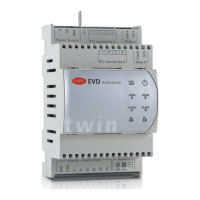ENG
“EVD Evolution TWIN” +0300006EN - rel. 2.6 - 31.01.2019
21
Key:
CP1, CP2 compressor 1.2
C1, C2 condenser 1, 2
L1, L2 liquid receiver 1, 2
F1, F2 dewatering lter 1, 2
S1, S2 liquid indicator 1, 2
EEVA, EEVB electronic expansion valve A,B
V1, V2 solenoid valve 1, 2
E1, E2 evaporator 1, 2
PA, PB pressure probe
TA,TB temperature probe
For the wiring, see paragraph “General connection diagram”.
Another application involves superheat control of two evaporators in the
same circuit.
E2
E1
V
M
S
F
L
CP
EEVA
C
EEVB
S2
S1
EVD evolution
twin
S3
S4
PA TA
PB
TB
Fig. 5.b
Key:
CP compressor
C condenser
L liquid receiver
F dewatering lter
S liquid indicator
EEVA, electronic expansion valve A
EEVB electronic expansion valve B
E1, E2 evaporator 1, 2
PA, PB pressure probe driver A, B
TA,TB temperature probe driver A, B
V solenoid valve
For the wiring, see paragraph “General connection diagram”.
Nota: in this example only one electronic pressure transducer
with 4 to 20 mA output (SPK**0000) can be used, shared between
driver A and B.
Ratiometric transducers cannot be shared.
Another possibility involves connecting two equal valves (operation in
parallel mode, see paragraph 2.5) to the same evaporator. This is useful in
reverse-cycle chiller/heat pump applications, to improve distribution of the
refrigerant in the outdoor coil.
S2
S1
EVD evolution
twin
S1
F1
L1
CP1
C1
S3
S4
A
E2
E1
V1
M
EEVA_1
EEVA_2
PA TA
S2
F2
L2
CP2
C2
B
E4
E3
V2
M
EEVB_1
EEVB_2
PB TB
Fig. 5.c
Key:
CP1,2 compressor 1, 2
C1,C2 condenser 1, 2
E1, E2, E3, E4 evaporator 1, 2, 3, 4
F1, F2 dewatering lter 1, 2
S1, S2
liquid indicator 1, 2
EEVA_1,
EEVA_2
electronic expansion valves driver A
EEVB_1,
EEVB_2
electronic expansion valves driver B
TA, TB temperature probe
L1, L2 liquid receiver 1, 2
V1, V2 solenoid valve 1, 2
For the wiring, see paragraph “General connection diagram”.
PID parameters
Superheat control, as for any other mode that can be selected with the “main
control” parameter, is performed using PID control, which in its simplest form
is dened by the law:
u(t)= K e(t) +
1
e(t)dt + T
d
de(t)
dtT
i
Key:
u(t) Valve position Ti Integral time
e(t) Error Td Derivative time
K Proportional gain

